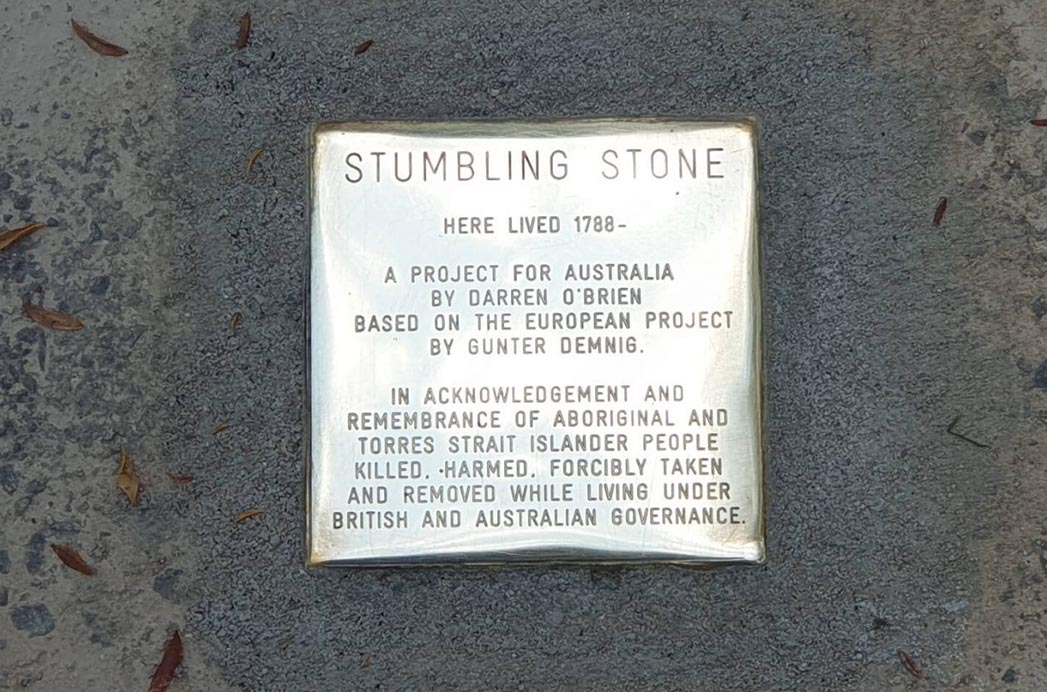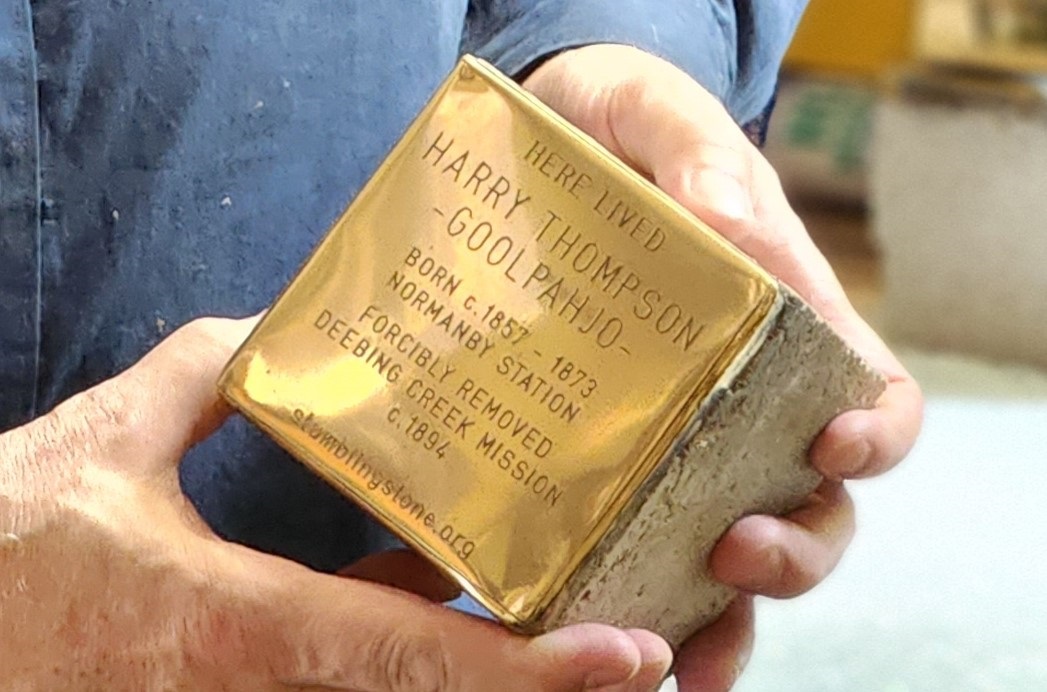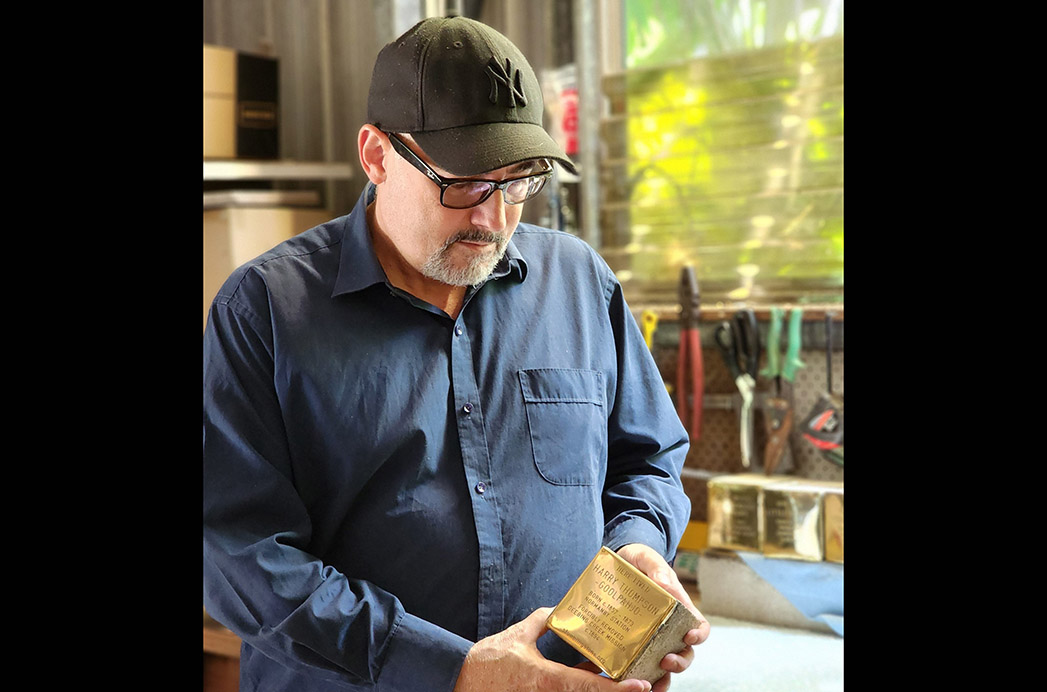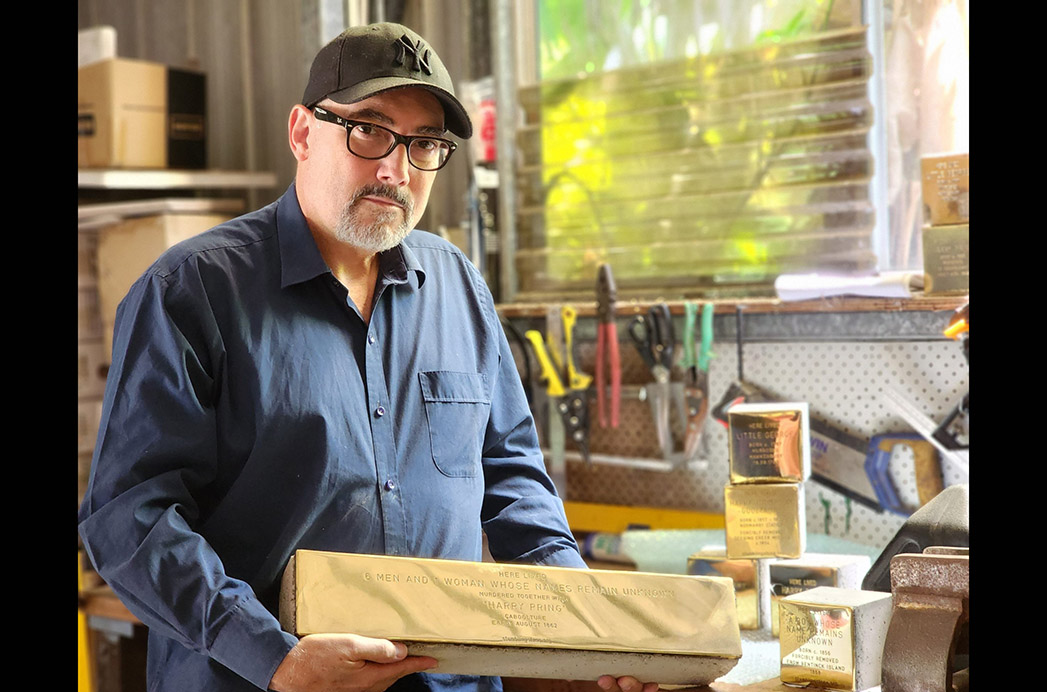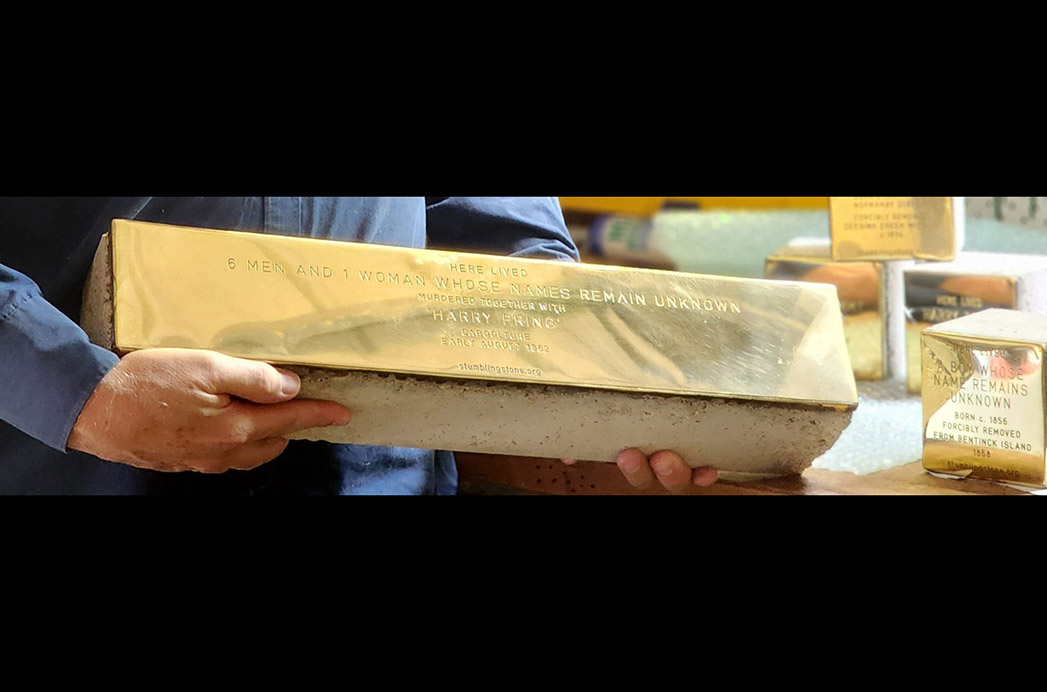Stumbling Stones
In collaboration with Aboriginal and Torres Strait Islander individuals, descendants and organisations, Dr Darren O’Brien remembers Aboriginal and Torres Strait Islander victims, survivors and resisters of British and Australian destruction by installing commemorative brass plaques in the pavement, on country, where each person last lived freely of their own choice. Each stone brings back to memory the people who once lived here. Almost every stone begins with ‘HERE LIVED’…
One stone. One name. One person.
FAQs
Stumbling Stones is a national research based truth telling project, aimed at commemorating Aboriginal and Torres Strait Islander men, women and children killed, harmed, forcibly taken and removed as well as those who resisted British and Australian exterminatory policies since 1788. It is undertaken in collaboration with Aboriginal and Torres Strait Islander organisations and individuals as well as descendants of victims, survivors, resisters and perpetrators.
What we went through will be difficult to understand even for our
contemporaries and much more difficult for the generations that
already have no personal experience of those days.
The stumbling stones and documentation together serve to inform contemporaries. The project is designed to facilitate grass roots conversation/yarning, interaction, historical understanding and commemoration that will inform contemporary attitudes, decision making, connection and equity.
Down this gully on a summer day, the police and settlers came. Nobody lives here now.
They stayed only a few hours. When they had gone, a community, which had lived for
thousands of years, was dead.
General “guidelines”.
Anyone can sponsor/fund a stumbling stone. An individual, a class or school, an institution, an organisation or a group of friends who wants to express acknowledgement and respect, in a public and tangible form, for Aboriginal or Torres Strait Islander victims who may have lived in their local town, area, state or beyond. This is a personal, grass roots, truth telling project. Each stumbling stone acknowledges/represents a life lived.
Individuals and institutions are welcome, invited and encouraged to identify, locate and help sponsor stumbling stones for Aboriginal and Torres Strait Islander families in order to commence an act of acknowledgement and remembrance for the killing and stealing times.
1. Consent 2. Inscriptions 3. Appointments 4. Placing/installation of Stumbling Stones 5. Costs 6. Stumbling Thresholds 7. Contact us
- Consent
Before a stumbling stone can be installed, permission must be obtained from the descendants (if known), local authorities, council, landholder, etc.
Success will vary. Sometimes it will be a painstaking process. Sometimes there might not be a response. We insist that everything be done to find and inform any living descendants or relatives before a stumbling stone is laid. They might want/like to attend a stumbling stone ceremony. Alternatively, they might not want a stumbling stone, in which case none should be placed for their relatives. It is also advisable to inform the current inhabitants of buildings if the stumbling stone is to be laid in front of the building along with council permission. This can prevent later problems or controversy. If possible, involve school children, university students and young academics in the process of laying a stumbling stone and carrying out research. Experience shows that there is great interest among young people. Contact details of Indigenous and non-Indigenous Research Associates (Junior through to Consultant levels of experience), who may be able to assist you, can be provided to you. Please email research@aihgs.org with your request and we will pass this information on. Negotiations regarding any fees (if/where payable) are undertaken between you and the individual Research Associate you are consulting for help not the AIHGS. You can of course research independently.
- Inscriptions
The ideal is ONE VICTIM – ONE STONE, however, when necessary a collective stumbling stone may be required. This project commemorates all victims of public (governmental/institutional) and private (settler/private land holder) anti-Aboriginal and Torres Strait Islander actions from the 18th century to the present – people persecuted for their Aboriginal and Torres Strait Islander existence – anyone who was persecuted, murdered, stolen or died as a by-product of systematic murder or assimilation policies. NB: Stumbling stones are not only placed for people who died, but also for resisters and “survivors”. For example, in front of a house in Brisbane, a stumbling stone might be placed for a girl who was stolen and survived the place she was forcibly taken to, alongside two stumbling stones for her siblings who were removed elsewhere and did not survive. The stones representing each person ‘act’ to bring the members of the family ‘back together’ in one place. Stumbling stones can also be placed for people who were able to escape, or survivors of missions, homes, camps or jails. The project also commemorates those who were forced by their circumstances to commit suicide. Therefore, please try to find out as much information as you can about the families of victims before requesting a stumbling stone. We also recommend that you do everything possible to find out as much information about a victim before sending us your proposed inscriptions. Please do not rely only on information from family members but carry out further research. Sources of information for research about inscriptions or addresses include local indigenous and non-indigenous communities, historical societies, town, state and national archives, Trove newspapers online, churches, historical societies, groups and associations, hospitals and government agencies. See the lists of works and organisations here (link) and here (link). The greater detail and accuracy you can discover the better. This material can be added to the linked stumbling stone website (link).
Inscriptions for stumbling stones should agree with the information found during your research. If your information does not tally, please inform the local historian/group you have consulted. They will do their best to amend their information.
If possible, stumbling stones are always installed (as feasibly as possible), as near to the last place the person is known to have lived freely – never in front of places that people were forced to move to. Therefore, they should never be placed in front of government reserves, stations or church missions. A stumbling stone usually bears the heading HERE LIVED. Exceptions might be made if a street/location no longer exists or if there is a reason for placing a stumbling stone in front of a place of employment for example. In such cases it might bear the heading HERE WORKED, HERE TAUGHT or HERE PRACTICED instead of HERE LIVED. Sometimes, there might be a case for not having a heading at all. The following information is required for the inscription on a stumbling stone, insofar as it is known or applicable: – First name, family name and maiden name (NO MORE THAN THREE NAMES) – Year or approximate year of birth (not full date of birth) – Full date of murder, removal or arrest if applicable – Information about internment in a camp/mission – Year (not full date) of removal to reserve/camp/mission/settlement (e.g., Flinders Island, Bogimbah Creek, Yarrabah, Cherbourg) – Full date of murder.
FLIGHT INTO DEATH is used in cases of suicide. If escaped, ESCAPE, YEAR and DESTINATION are preferred. If a fate is not known, then the inscription FATE UNKNOWN can be used. If somebody survived a camp/mission/settlement/jail, then please use the term LIBERATED instead of SURVIVED. In some cases it might be more suitable to place the stumbling stone in the centre of the nearest modern day town or city if the person lived on country where the town is now situated. Once you have been given a date for the laying/installation of the stumbling stone, please send inscriptions in a WORD document per e-mail to info@stumblingstone.org who will provide you with a template. We need to receive inscriptions at least three months before the given date. You will receive the inscriptions for proofreading before the stumbling stones are made. If you have any questions, we will gladly correspond with you. Darren O’Brien will consult with Research Associates where necessary and has final say on the inscriptions. The stumbling stones are a “work in progress” and sometimes there will be changes to wording of inscriptions as the project develops.
- Appointments for placement of a stumbling stone
We do our best to accommodate all requests. However, we cannot meet every demand and certainly cannot grant/guarantee all requests for stumbling stones will be laid on a particular date. The earlier we receive your requests, the earlier an appointment can be made. Please do not ask for an appointment for a stumbling stone to be placed unless you already have permission from the local authorities and descendants and until you have carried out all the necessary research for the inscriptions. We try to announce the installation timetable six months in advance. Once times and dates have been fixed, they remain subject to change. This might be because of last-minute cancellations or for reasons pertaining to weather or illness. Sometimes, these trips may have to be re-arranged entirely. Please be aware that the stumbling stones will be placed on all days of the week regardless of public or religious holidays. It is suggested that people organize unveiling ceremonies on later dates if the laying of a stumbling stone clashes with a public/religious holiday.
- Placing/installing a stumbling stone.
A stumbling stone is a cube that is 96 x 96 mm big and 100 mm high. A hole should not be more than 12 cm deep. Darren O’Brien tries to place as many stumbling stones as possible himself – he ALWAYS places the first stumbling stone in a new place. Stumbling stones are never placed on/in a wall but always on a thoroughfare or pavement – in contact with the land – usually directly in front of the entrance or location of where the person last lived of their own free choice. Darren usually decides where exactly they should be placed at a given location on the day itself. Darren tries to keep families ‘together’ by placing stumbling stones for them as a unit – stones for parents will be placed above those for children in this case. Where possible, please request help from the local council authorities (with preparing the holes or removing rubble for example) well in advance of the given date. In some council areas, help is compulsory. If there is no help from the local authorities, please ensure that Darren has access to electricity as well as a pair of extra hands to help remove rubble etc. It makes sense to provide information about the surface where a Stumbling Stone might be placed in advance if possible – bitumen, concrete etc. Darren can then prepare his work more thoroughly. As a general rule, Darren needs 20 minutes per address if he has the assistance of the local council authorities. When planning his itinerary, please ensure you leave enough time for Darren to travel from one address to the next. If necessary, please ensure that you have obtained permission for Darren to park. If a stumbling stone is stolen or damaged, please contact info@stumblingstone.org. Everything will be done to replace the Stumbling Stone as soon as possible.
If you want to place a Stumbling Stone without our help (NB: This is only possible if a stone has already been placed in a given location (so it is a replacement).
- Costs
For an initial period of time, a limited number of stones are being created by Darren for free. It usually costs $240 (INCL. GST) to install a stumbling stone. This includes the making of the stone and its placement or delivery if applicable. All the stumbling stones are made by Darren O’Brien in Brisbane. Stumbling stones are financed by private funders. Private individuals, institutions, educational establishments, companies, associations, or political parties might choose to “sponsor” a stumbling stone. We work on a principle of trust. You will only receive an invoice for a stumbling stone once the stone has been laid/installed. Please do not transfer any money before receiving an invoice. Please indicate the invoice number when transferring payment.
- Stumbling Threshold
There are certain cases when hundreds of stumbling stones would have to be laid in a single place. This being almost impossible, the stumbling threshold can commemorate a group of victims in a few lines. Like a stumbling stone, a stumbling threshold is 96mm wide but is 515mm in length. It can hold up to six lines of text. Like the stumbling stone, each stumbling threshold is custom made.
- Contact us
Darren O’Brien E-mail: darren.obrien@stumblingstone.org Mobile phone: 0423933130. For requests, inscriptions, appointments, coordination, questions, invoices, education, press photos E-mail: info@stumblingstone.org For research help email: research@aihgs.org


